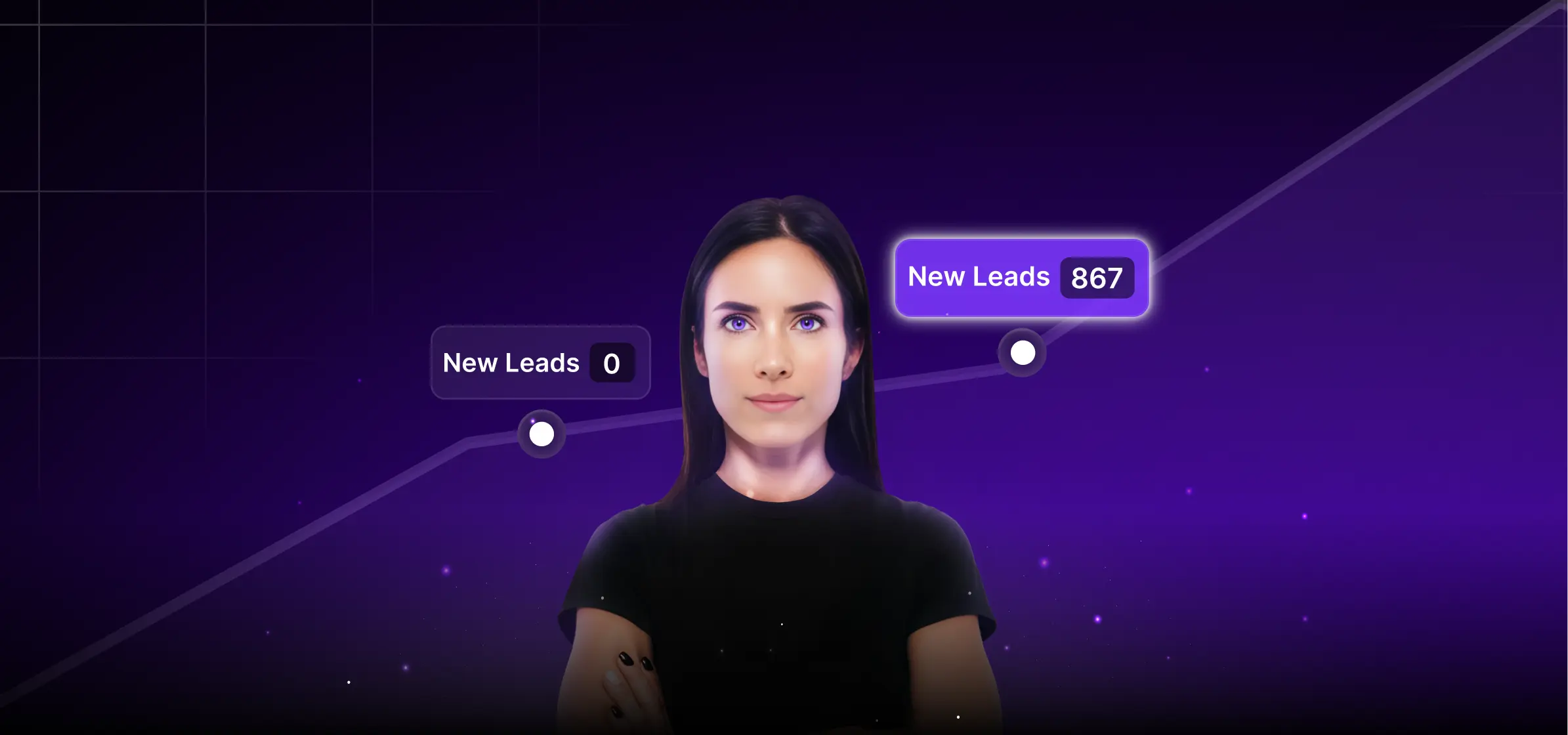The best SDRs are proactive and persistent.
They need to be. They have a very tough job—turning strangers into leads through cold calls, emails, and other interruptions.
But hiring the right people isn’t enough on its own. You need rock-solid processes, clearly defined roles, and a supportive, energizing culture.
What Is an Outbound SDR?
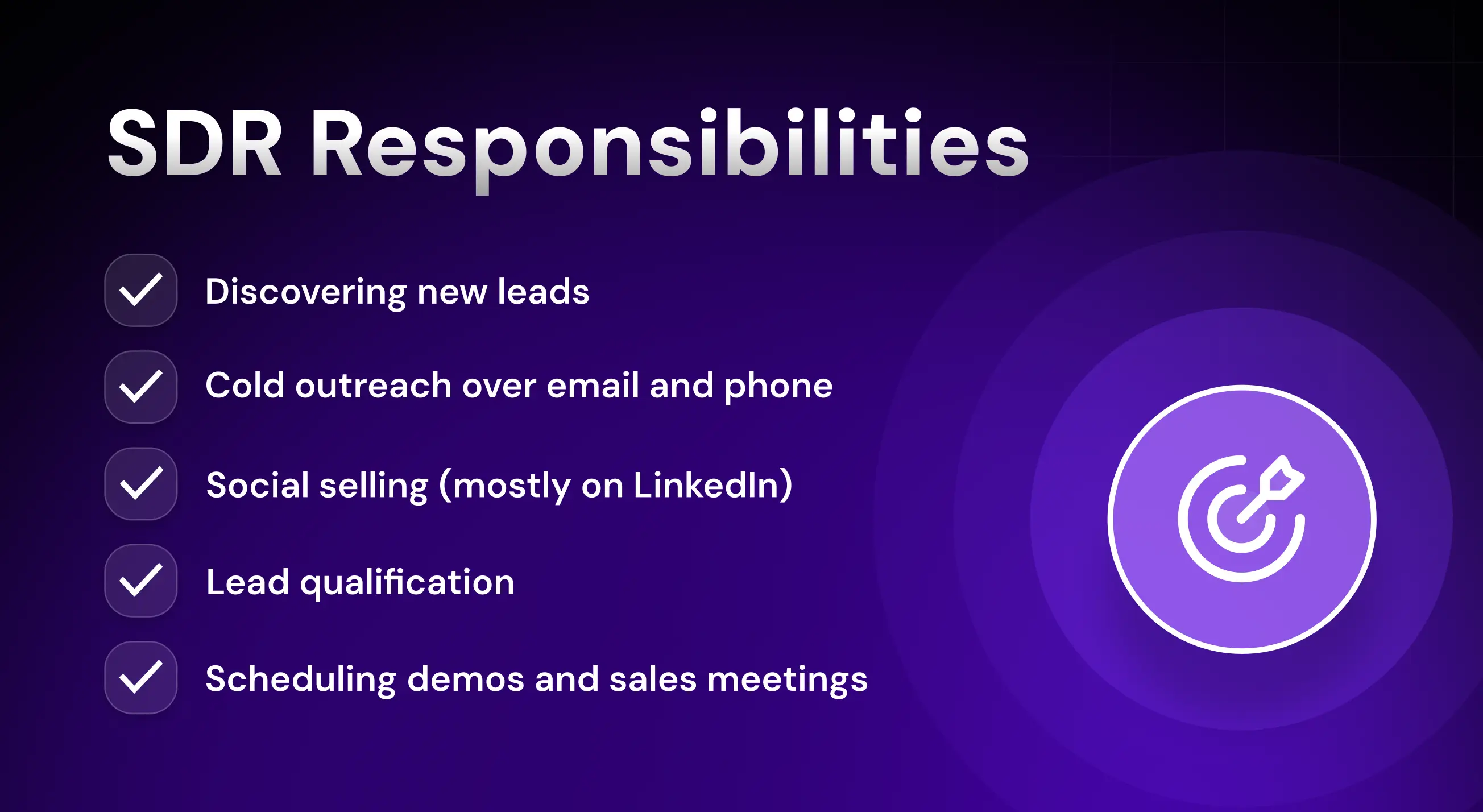
An outbound sales development representative, or SDR, is a sales rep who proactively reaches out to cold leads to generate qualified meetings. The term “outbound SDR” is used interchangeably with “business development representative” or “BDR.”
SDRs use a variety of outbound sales methods, including cold emailing, social selling, and cold calling. The role is most typically found in B2B SaaS companies that want a repeatable way to generate pipeline for their account executives (AEs).
Here are the core responsibilities of the SDR role:
Prospecting: Find and research businesses and decision-makers that fit the company’s ideal customer profile (ICP).
Cold outreach: Reach out to target leads over cold calls and cold emails. The goal of this outreach is to pique interest, build rapport, and have the lead book a demo or discovery call.
Social selling: Use social platforms like LinkedIn to engage with decision-makers and conduct cold outreach.
Lead qualification: Ask the lead questions, based on a lead qualification framework, to assess if they are a good fit for the product or service (and worth meeting).
Appointment setting: SDRs are in charge of putting meetings on the AE’s calendar, as well as introducing the new prospect to the AE, usually over email.
Compared to inbound SDRs, who focus on converting warm leads, outbound SDRs target new leads who haven’t expressed any interest in your product or service. That proactive nature is why SDRs are often called hunters.
And what makes a successful hunter? SDR performance is evaluated using metrics like outreach volume (e.g., calls per day), connect rate, and, most important of all, the number of qualified meetings booked.
The Outbound SDR Sales Process
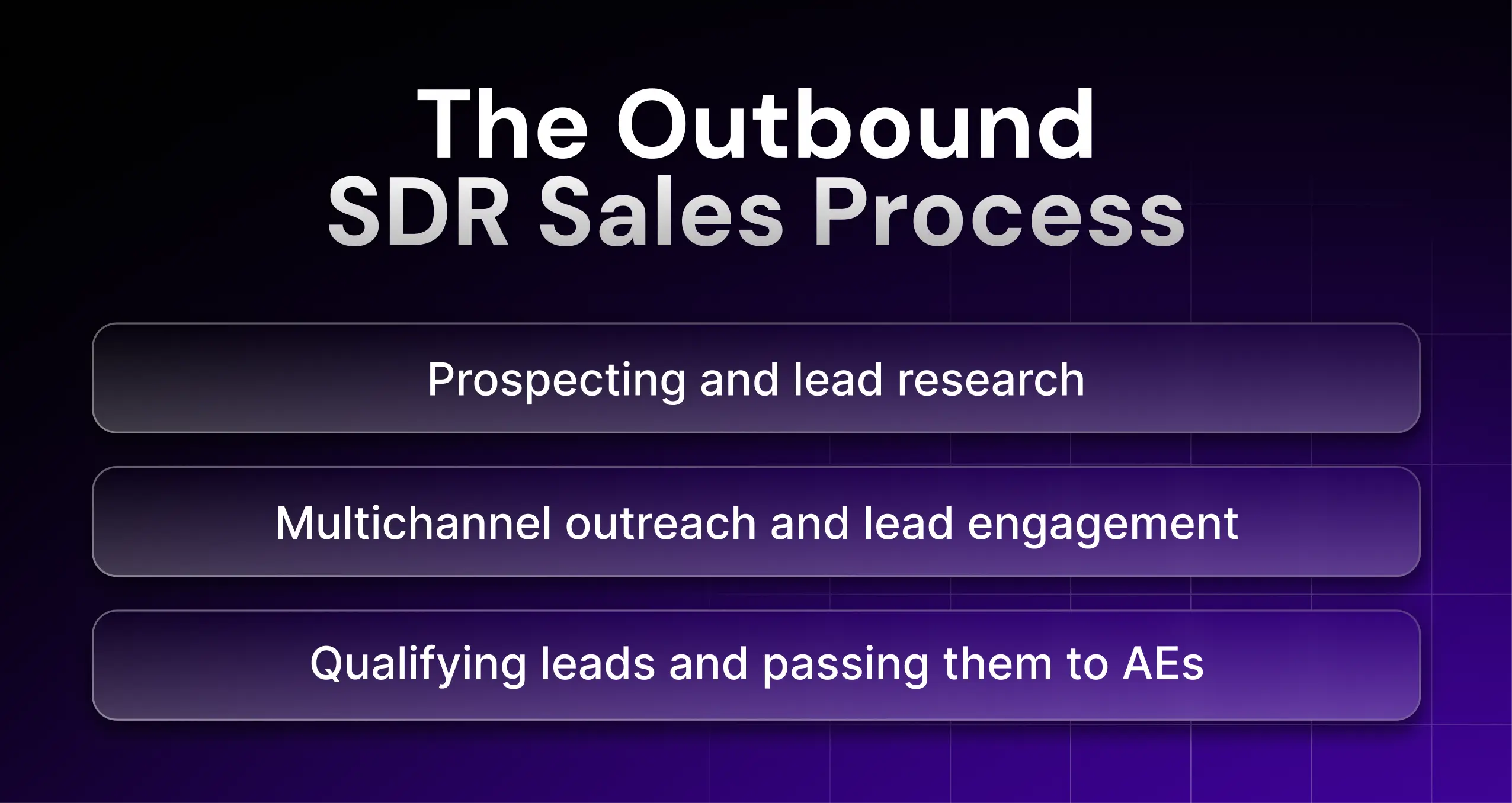
The outbound sales development process is all about pulling high-quality leads into your sales pipeline.
Let’s look at the three major stages of this process and how to execute them.
1. Prospecting & Research
SDRs start the prospecting stage by compiling targeted lists of leads. Typically, they create different lists for different buyer personas.
For example, an SDR team might create a list for marketing VPs in the financial services industry, and another for digital marketing directors in the tech industry.
Segmenting leads by specific ICP criteria—like industry, company size, and job title—enables them to predict the lead’s pain points and create highly resonant cold call scripts and emails. These tailored messages generate better responses from leads than generic ones.
To automate the list-building process, SDRs often use B2B database tools with filters that allow them to find high-quality leads, research them, and collect contact information. LinkedIn Sales Navigator is one of the best-known examples of a B2B database.
But, once they have their lead list, there’s still research to do.
Before making any cold calls, SDRs search for specific intel they can use to personalize their outreach messages, like recent funding rounds or job promotions. The aim is to cause leads to think, “Wow, they’ve sure done their homework!”
2. Outreach (Multichannel Engagement)
The best SDR teams use multichannel outreach campaigns to contact leads over several weeks. These sequences often include touches across email, phone, and social.
Here’s how to execute the three most common outreach methods:
Cold calls: Make calls to decision-makers and deliver highly personalized elevator pitches focused on problems you solve for businesses like theirs.
Cold emails: Send short, value-packed emails that focus on one challenge or pain point you can help the lead overcome.
Social touches: Send personalized LinkedIn connection requests or InMails referencing relevant details about the lead and their business.
Sales engagement software is critical here. Without it, reps struggle to manage their outreach and track where leads are in their respective cadences, especially if they’re running several targeted campaigns at once.
Dedicated sales software automatically prompts reps to take certain actions, whether it’s “cold email lead” on day one or “reach out on LinkedIn” on day five.
Some tools, like Artisan, take outreach a step further with AI automation features. Outbound AI SDR Ava, for example, doesn’t just recommend next steps. She writes, sends, and follows up on cold emails and LinkedIn messages on autopilot.
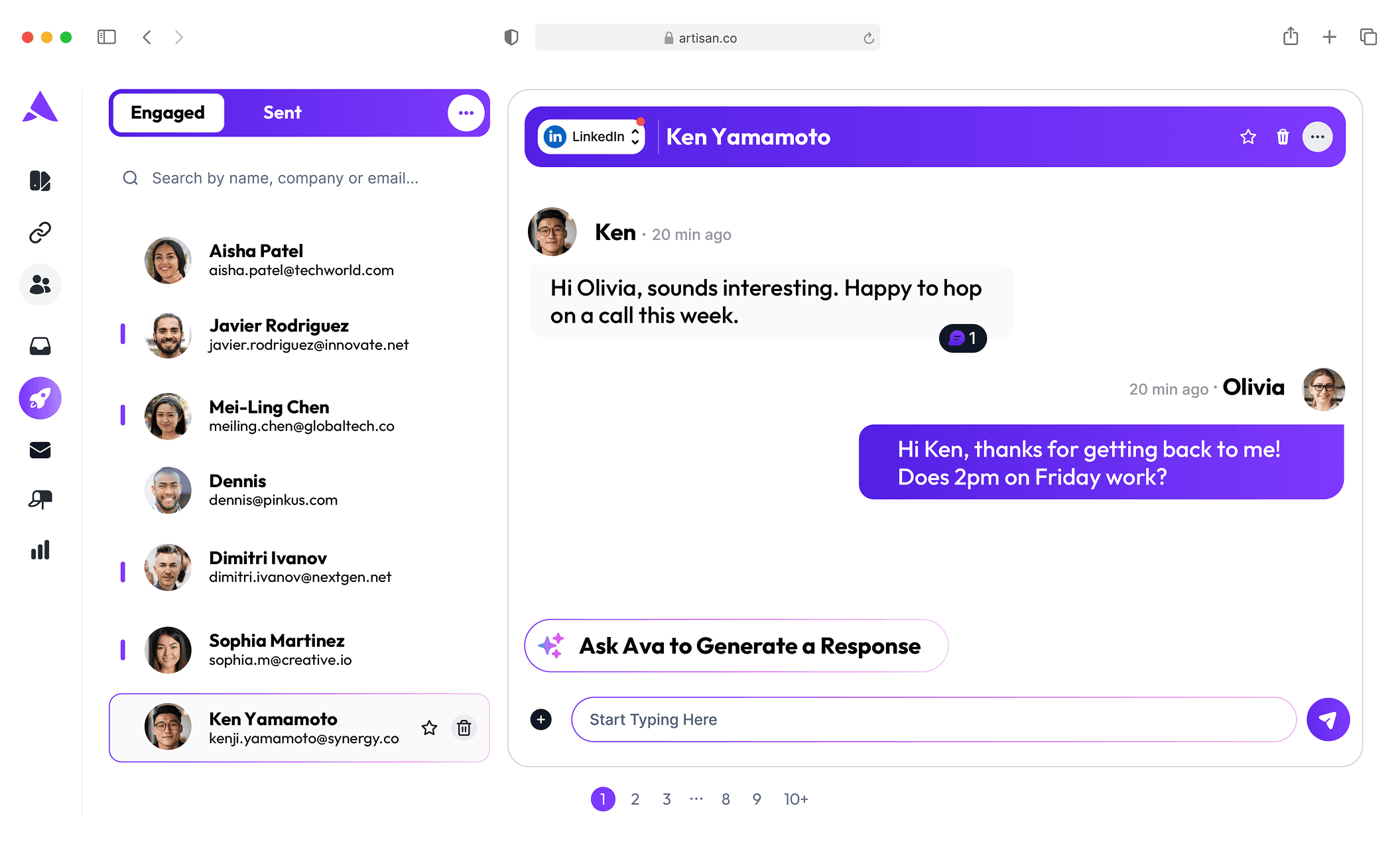
3. Qualifying & Handoff
Before an SDR can book a meeting, they have to qualify the lead to make sure they’re a good fit.
Otherwise, they’ll fill the AE’s schedule with a poor-quality pipeline, and they will waste time demoing the product to people who will never buy it.
There are two ways your SDR team can qualify leads:
Conduct discovery calls: In more complex sales, where it’s hard to tell if a business needs the product, SDRs will hold discovery calls with leads and perform a needs analysis.
Qualification frameworks: These are sets of criteria that leads must meet to advance to the AE stage. A classic framework is BANT, which stands for budget, authority, needs, and timeline.

If the lead is qualified, the SDR schedules time for the lead to meet with the AE who owns the account, usually for a live demo or consultation.
SDRs will record details about past interactions in the CRM so AEs have context before the call. This way, the prospect doesn’t have to start from scratch, re-explaining their business, problems, and needs.
If the SDR did their job well—finding, warming up, and qualifying the lead—the AE should have an easier time closing the deal.
Essential Tools & Technology
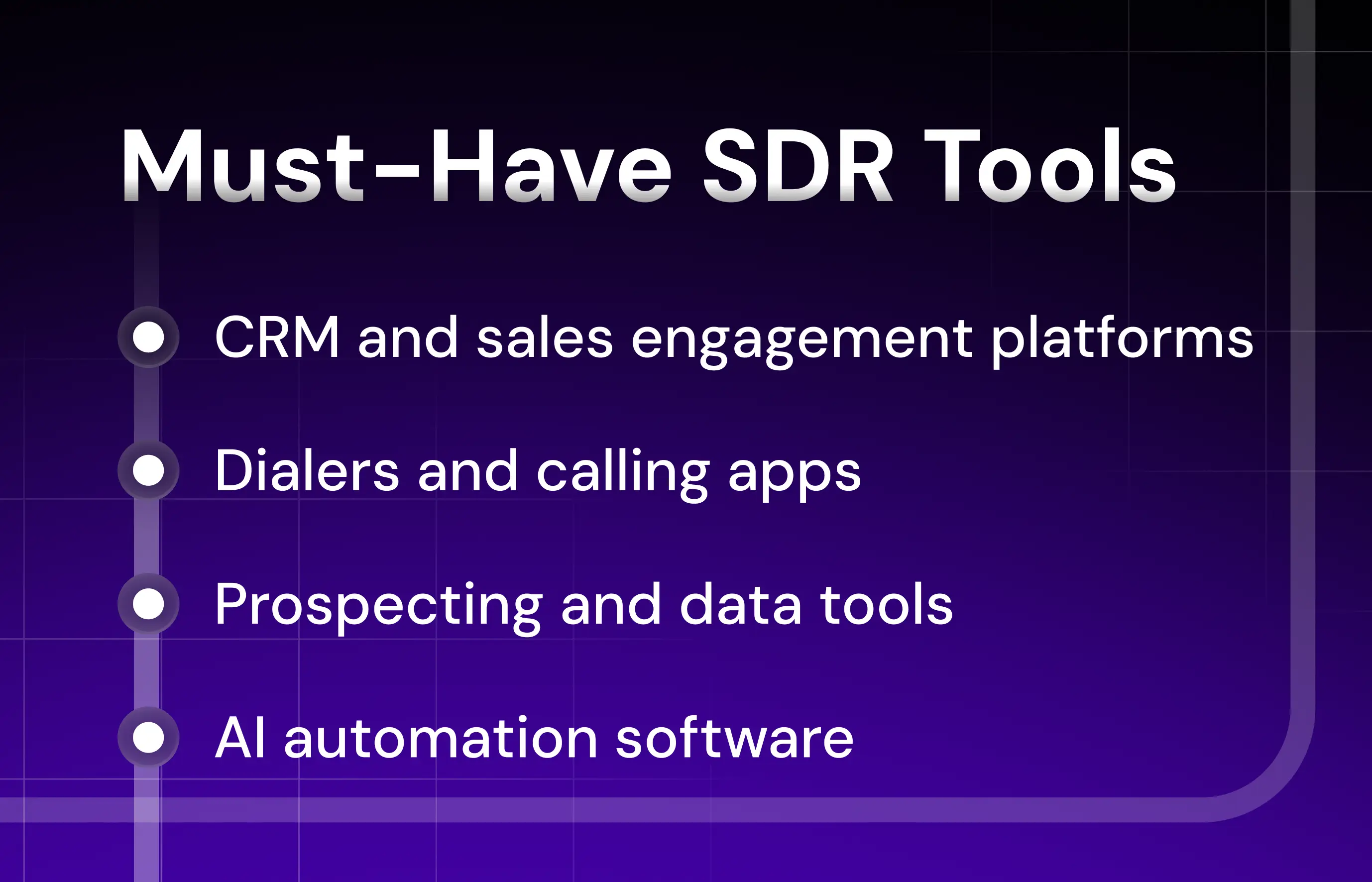
Tools play a large role in the day-to-day work of an SDR.
Platforms like sales engagement software and integrated dialers help them automate outreach, streamline message personalization, and track key SDR metrics.
Let’s go over the four most important types of salestech for outbound prospecting and lead generation.
CRM & Sales Engagement Platforms
CRMs like HubSpot or Salesforce help SDRs track and organize lead information. And sales engagement platforms like Artisan help them automate their cold outreach, follow-up, and message personalization.
Aside from LinkedIn Sales Navigator, sales engagement platforms—that assist with connecting with and nurturing leads—are the most popular tools for outbound sales teams, with 77% of teams using them, according to a report by The Bridge Group.
Dialers & Calling Apps
To speed up cold calling, SDRs use two primary tools:
Power dialers that automatically dial numbers on a list until a lead picks up, eliminating manual dialing and wait time between calls.
Calling apps that connect with your CRM and allow you to call directly from a contact record, with the click of a button.
According to The Bridge Group, 69% of respondents use some sort of call recording and conversation analytics technology. These tools, like Gong or Clari, give reps and sales coaches insights into what’s working so they can improve their scripts and tactics.
Prospecting & Data Tools
Before they begin outreach, SDRs need to find high-quality leads along with their contact information. But Googling “real estate companies” and visiting the company websites’ About Us pages to find the name of the VP of property management is an inefficient way to do this.
Instead, SDR managers invest in sales intelligence and B2B database platforms like Cognism and ZoomInfo, which contain demographic, firmographic, and technographic information on millions of B2B companies and contacts.
SDRs also use the search filters of these tools to quickly build audience segments, like “VPs of marketing at healthcare companies in Nebraska.”
Some outreach automation tools also come with built-in B2B databases. Artisan’s database has up-to-date information on over 300 million B2B, local, and ecommerce contacts.
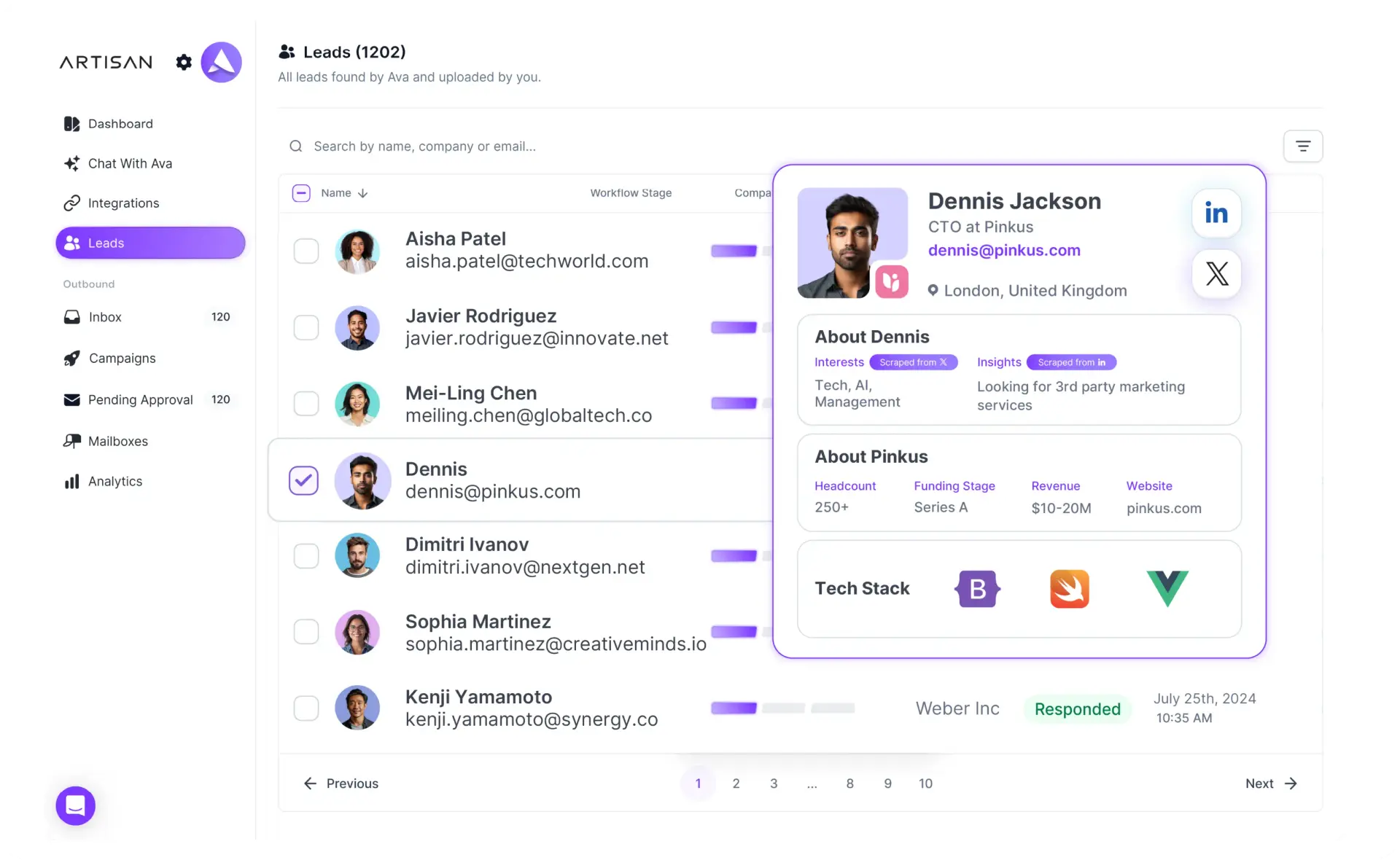
AI & Automation (Innovation Spotlight)
In HubSpot’s State of Sales Report, 80% of respondents said they had implemented AI-powered tools into their sales process.
What explains this rapid adoption? It's simple: AI makes your sales team far more efficient. It allows you to scale your personalized cold outreach without hiring new reps.
There are plenty of AI tools out there, but the newest and most groundbreaking application for outbound sales is the AI SDR.
This type of software takes traditional sales engagement platforms to the next level. Instead of helping reps do cold outreach tasks like follow-ups more quickly, an AI SDR handles all of the early and middle stages of the outbound sales process.
For example, SDR Ava, the AI employee at the center of the Artisan platform, can do all the following:
Find ideal leads that fit your ICP from a database of over 300 million contacts
Collect relevant details about lead activity from social media and the web
Create personalized, multichannel sequences tailored to leads’ online behavior
Reach out to, and follow up with, leads over email and LinkedIn
Monitor campaigns and adjust them according to lead engagement and response rates

Outbound vs. Inbound SDR
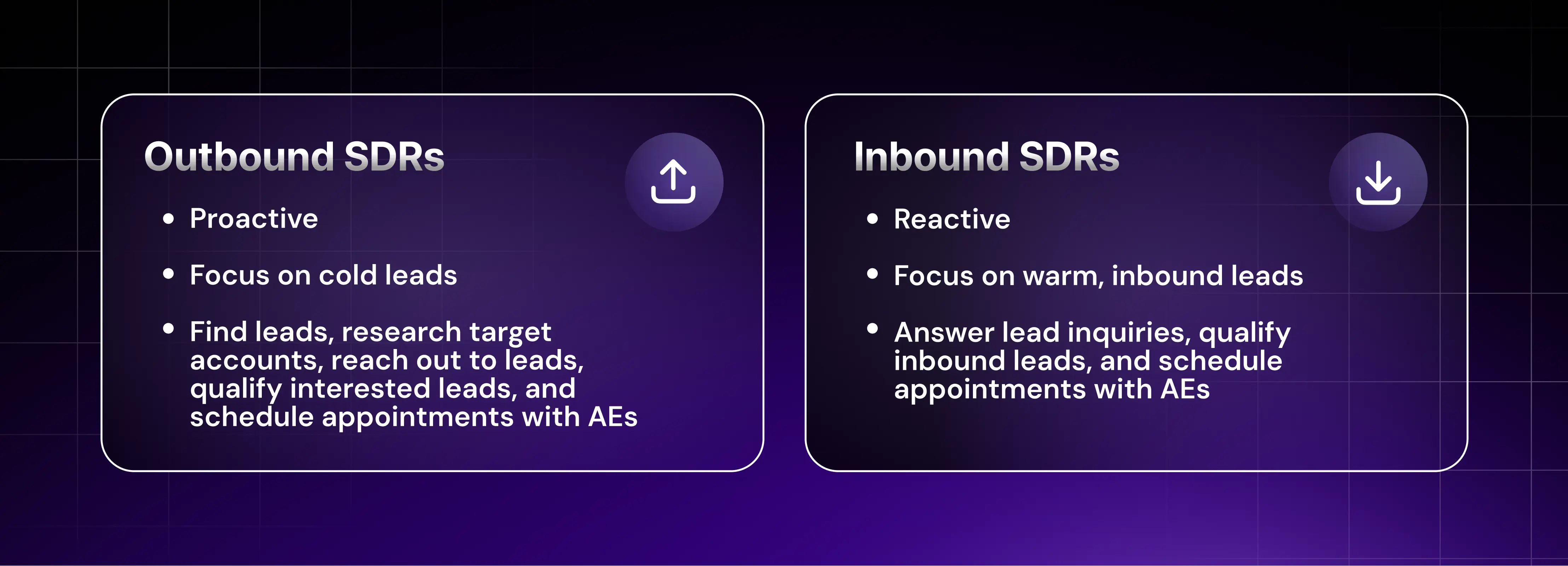
Outbound SDRs, often referred to as BDRs, initiate contact with cold leads.
They are hunters searching for and reaching out to potential buyers that fit the company’s ICP. Meanwhile, inbound SDRs are reactive, responding to inbound leads who have filled out a form, downloaded content, or raised their hand in interest.
When it comes to KPIs, outbound reps are scored on outreach volume, connect rate, and meetings set. Inbound reps, on the other hand, are measured on their lead response time and MQL-to-SQL conversion rates.
A hybrid strategy, combining both inbound SDRs and outbound SDRs, is the best approach for most businesses. It ensures you’re both hunting and gathering, both of which are necessary for pipeline diversification.
Best Practices & Strategies for Outbound SDRs
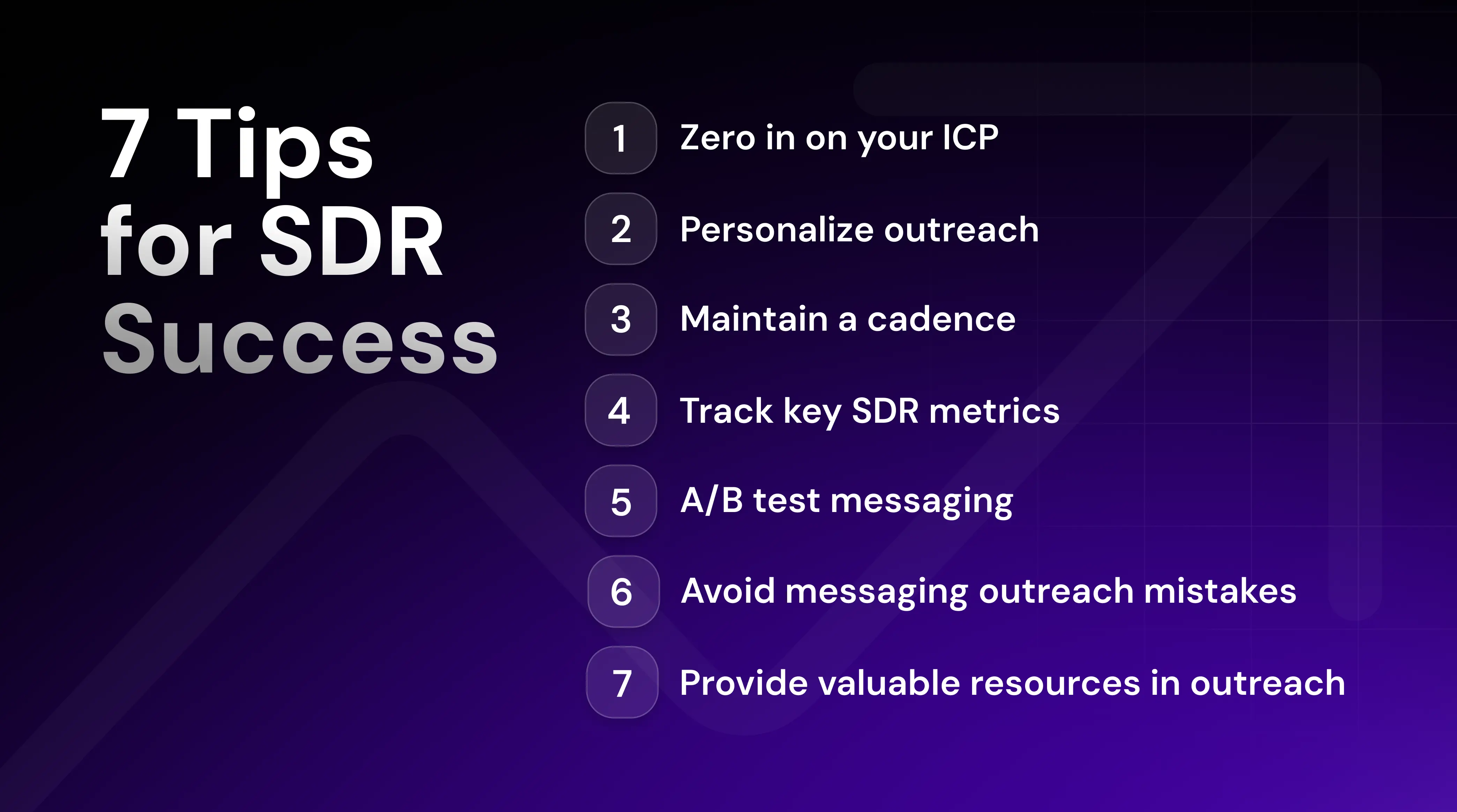
From focusing on your ideal customer profile to tracking SDR metrics, let’s look at the tactics deployed by the most effective outbound SDR teams.
Focus on Different ICPs
Consider creating separate lead lists and outreach campaigns for your different buyer personas. This way, even when you’re bulk emailing or executing a cold call sprint, your messaging is always tailored to each lead’s specific pain points, company type, and role.
To illustrate, an SDR selling salestech might have one campaign for sales managers where they focus on pain points and features associated with coaching sales reps.
Meanwhile, they have another campaign for VPs of sales. Here, they focus on issues relevant to sales planning, forecasting, and revenue quotas.
With this targeted lead gen strategy, the SDR will perform much better than if they had thrown these two distinct buyer personas into a single list.
Personalize Outreach
Personalize all outreach messages, especially your opening lines. You want to make the lead feel like your message is for their eyes only right off the bat. Otherwise, they won’t respond.
Good personalization comes down to research. Dig into social media, company websites, and B2B databases for relevant intel that you can use to convince leads you understand their situation and aren’t just spraying and praying.
Here are the best types of intel for personalizing cold outreach:
Company news, like office expansions and new product launches
Recent funding rounds
Mutual connections
Recent promotions or job changes
However, personalizing emails and LinkedIn DMs can take a lot of time. That’s why reps are increasingly turning to AI SDR tools like Artisan.
Artisan speeds up outreach by auto-personalizing content at scale. Outbound AI SDR Ava scrapes the web and social media platforms for lead information and uses it to craft tailored messages that read as well (and even better) than human-written ones.
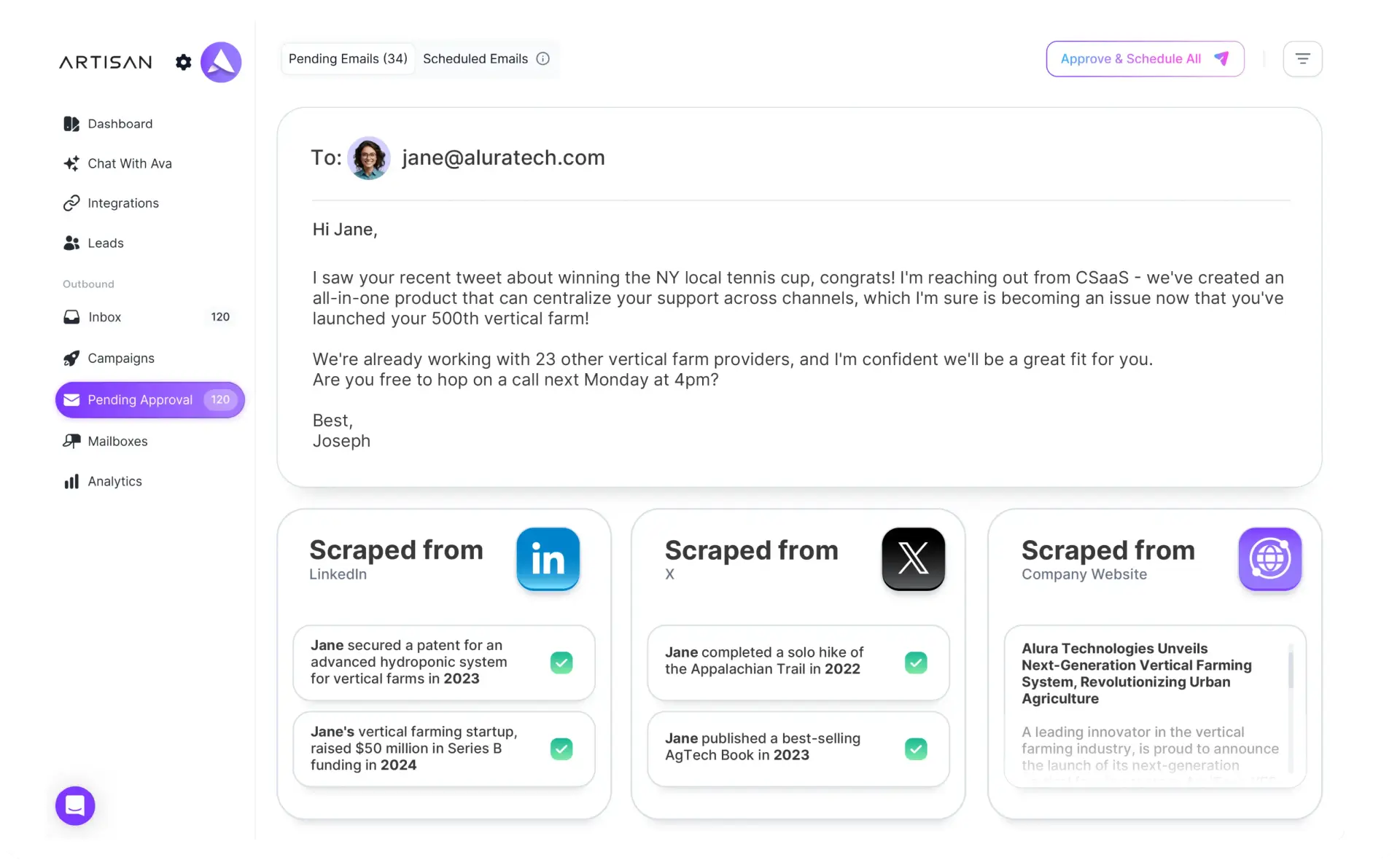
Maintain Cadence
Don’t give up after a single cold email. Continue following up with leads across multiple channels—email, call, LinkedIn—over several weeks.
According to research by Nutshell, three follow-up emails over two weeks is the sweetspot. You can, of course, mix this up with other outreach types.
Here’s a sample cold outreach cadence:
Day 1: Send a cold email introducing the major problem you solve.
Day 2: Send a connection request on LinkedIn.
Day 4: Place a cold call and leave a voicemail.
Day 6: Send a follow-up email with a case study.
Day 10: Place another cold call.
Day 14: Send a LinkedIn follow-up message pitching your solution.
Day 16: Send a third break-up email.
The best outreach strategies combine email with LinkedIn social selling. This allows reps to reach leads across a variety of touchpoints, increasing the likelihood of a response.
Lee Smith, CEO of SalesFuel, is a big believer in LinkedIn for lead gen. However, he’s careful about when he pitches. “We never pitch in the connection request or immediately after because it ruins trust. Instead, we engage with their posts, comment meaningfully, and then follow up with a message that reflects that interaction.”
Track Metrics
Tracking outreach metrics gives you the information you need to assess your outbound strategy’s strengths and weaknesses, find coaching opportunities, and improve SDR team performance.
Here are the SDR metrics you should track:
Email reply rates: How often leads reply to your cold emails
Email open rates: How often leads open your cold emails
Campaign conversion rates: How effectively campaigns generate sales opportunities
Meetings booked ratios: Cold calls made to booked meetings
Pipeline values: Total potential value from all SDR-sourced deals in the pipeline
Connect rates: How often you connect with leads on cold calls
CRMs and outbound sales tools let you track these metrics with custom reports, dashboards, and real-time analytics. Artisan’s LinkedIn outreach analytics dashboard, pictured below, is a good example.
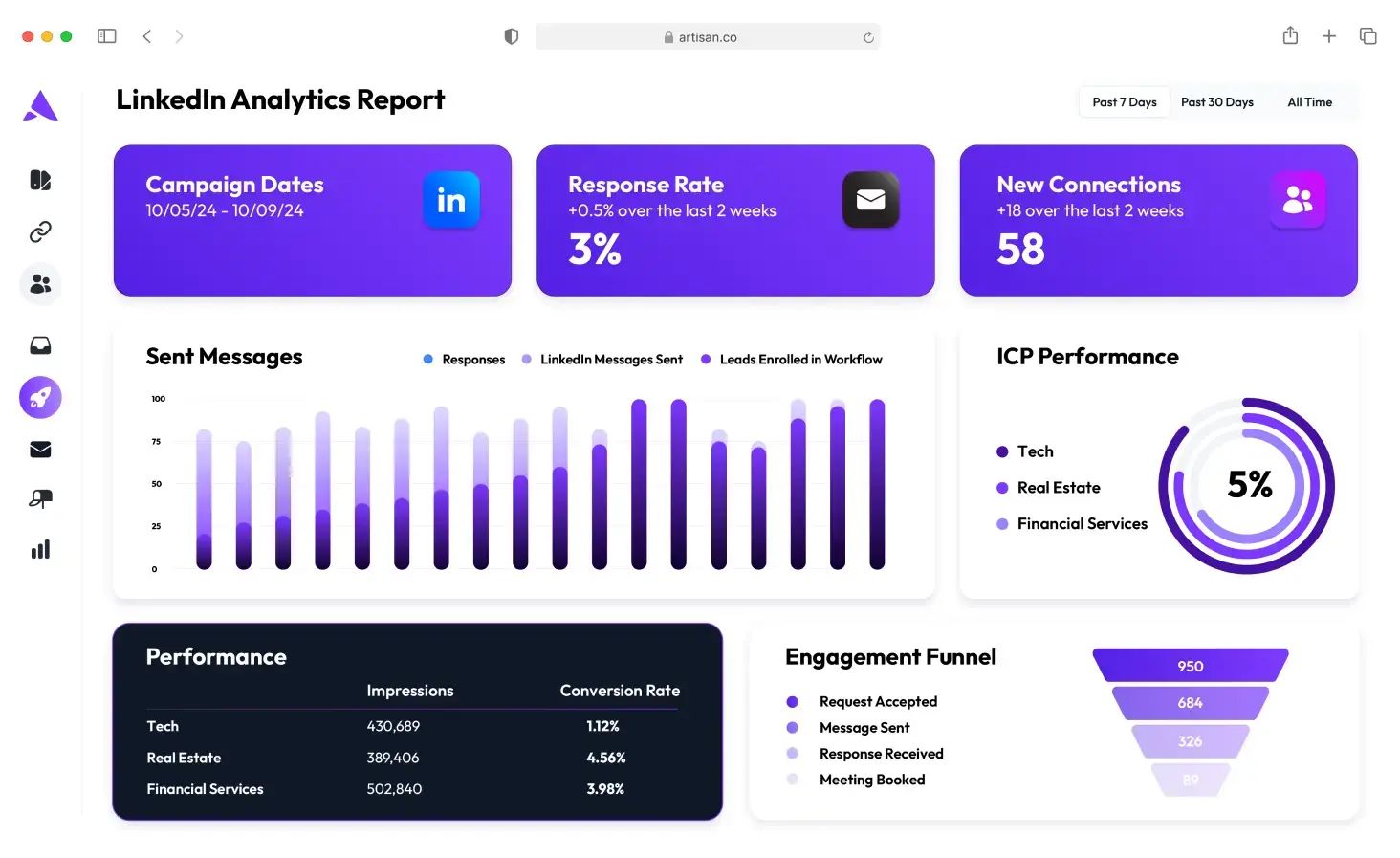
A/B Test Messaging
The best SDR managers are scientists.
They constantly run A/B and multivariate tests to evaluate the performance of different subject lines, email lengths, personalization methods, and call openers. Gradually, they approach an optimized outbound sales process.
Most B2B sales tools give you the ability to pit outreach methods against each other. For example, a sales engagement may let you run two outbound email campaigns and track which has the higher click-through and meetings booked rate.
Some AI sales tools, like Artisan, take it a step further and automatically run A/B tests in the background, so you don’t have to think about it. Instead, you can rest assured that your sales outreach messaging is constantly improving based on real data.
Avoid Common Pitfalls
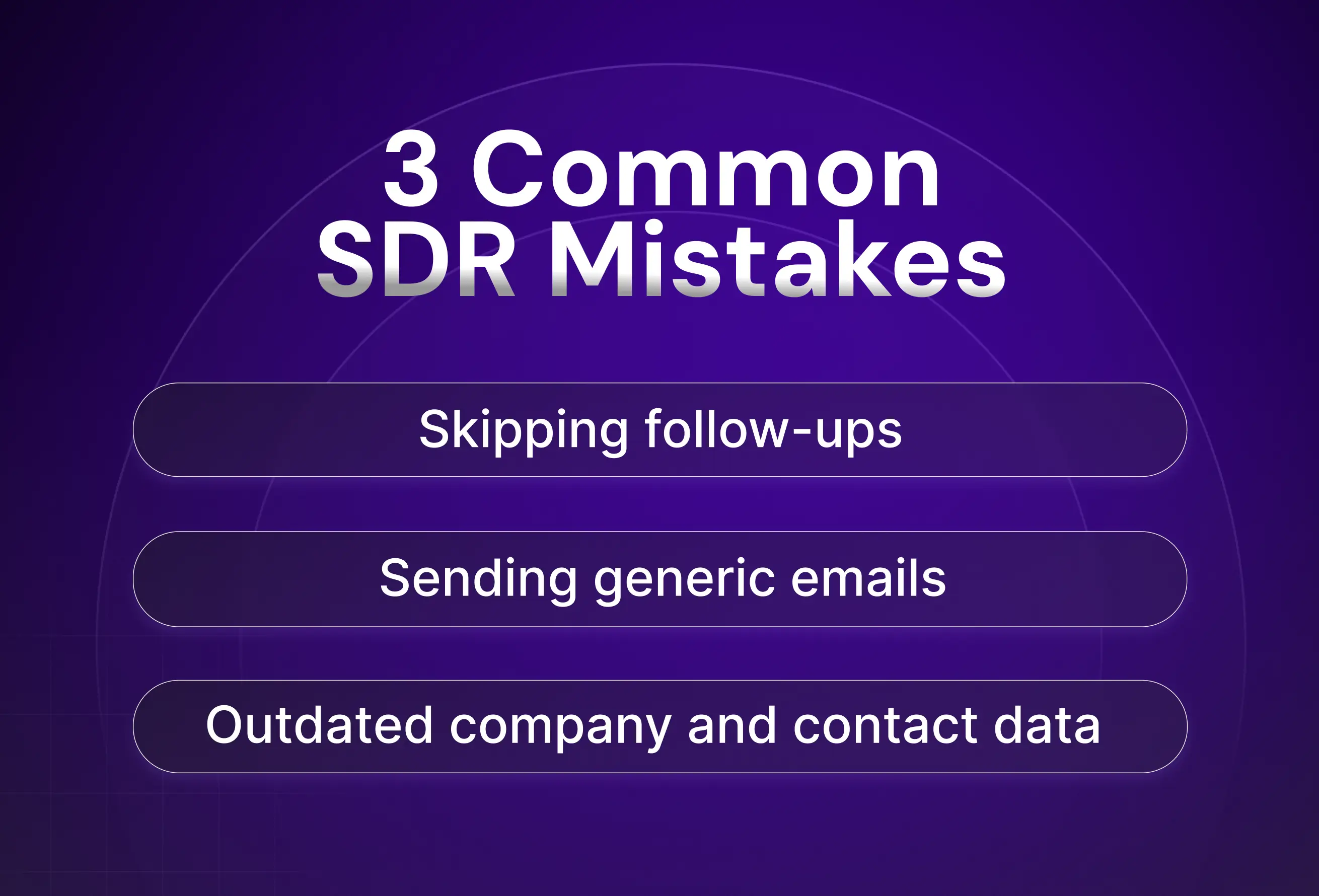
There are three big mistakes your SDR team must avoid:
Skipping follow-ups: In cold outreach, don’t give up on a cold lead until you’ve made at least 10 touches, preferably spread across phone, email, and LinkedIn. Most leads require several nudges before they’ll get on the phone. The money is in the follow-up.
Generic email blasts: Impersonal outreach gets you nowhere. Personalized messages, on the other hand, make your leads feel understood, especially if you can describe their unique problems better than they can.
Neglecting CRM data: Inaccurate contact information, like wrong phone numbers, hinders your ability to reach your leads. And outdated lead data makes personalization impossible. Use a B2B data enrichment tool to keep CRM data fresh.
Integrate Content
Content marketing is a great cold outbound strategy, especially for following up with leads. An educational piece of content, whether it’s an ebook or case study, can establish your team as expert problem-solvers and give the lead that push they need to agree to a meeting.
For example, if a lead isn’t responding to your LinkedIn outreach, you could send them a blog post that walks them through how to solve a problem you expect they’re dealing with. Or you could send an invite to a webinar breaking down a new industry trend they’re interested in.
Scaling the Funnel Without Scaling the Team
Most sales funnels break down when they start to scale.
There are just too many leads and too few SDRs to handle the follow-up, outreach, and personalization.
Fortunately, there’s another way. AI tools like Artisan allow you to automate email sequences, lead scoring, and CRM workflows. AI SDRs don’t replace sales professionals—they act as rocket fuel for prospecting and outreach.

